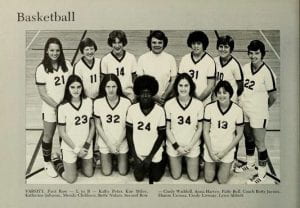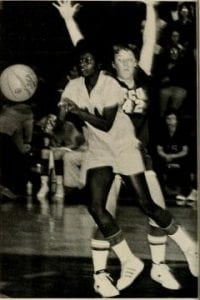Post Author: Jacob Houser

“We didn’t even think about it, we were just there to play the game” (Johnson, 2013). These were the words of Katherine Johnson (’77), James Madison University’s first female All-American athlete, when discussing the prevalence of Title IX and women’s sports during her time in college. Johnson attended Madison College from 1973 to 1977. During her four years, Johnson was named to the Virginia AIAW All-State team in 1974, 1975, and 1976, while also setting 15 Women’s Basketball records (#1988). She was a pioneer for women’s sports at this institution and is still respected on campus today.
Johnson first visited Madison College during her senior year of high school. She said that recruitment of high school players was nowhere near as publicized as it is today. Set on attending college elsewhere, Johnson visited Madison College to appease her high school basketball coach, who had attended Madison College. “Godwin Hall [once the home court of the basketball teams] looked huge and the campus was gorgeous,” Johnson said of her first visit (Johnson, 2013). To top it all off, she happened to meet some top Madison College brass during her first visit as well. “I was in the gym, shooting, when President Ronald Carrier came up to me and began talking to me, asking me if there was anything that I needed and asked how my day was going. I knew then and there that I would come to Madison” (Johnson, 2013).

Johnson described the relationship between the men’s teams and the women’s teams as respectful to one another, but women received much less funding. She said that even though Title IX was in effect, there was no real governing body to enforce it, so men received much more coverage and funding than the women. Despite these differences, Johnson insists that the student athletes did not even think about it much. “It was just how things were done,” she says (Johnson, 2013). Despite the discrepancies in funding and coverage, Johnson reveals that there was a mutual respect between the men’s and women’s basketball teams. She said that the coaches were respectful to one another in that they both shared the college’s only court for practice and games. Both coaches were also respectful to the players. “There were many times in which the boy’s coach, Coach Campanelli, would give me advice on how to better my jump shot, and I liked talking to the guys because they could expand and improve my game,” said Johnson of the boy’s basketball team (Johnson, 2013). Johnson also feels that Dr. Carrier’s influence helped to promote the feeling of equality among teams and that it was he who helped make all athletes feel special (Johnson, 2013)
Despite the inequality of funding, Johnson said that she felt respected by and equal to the men’s basketball team, at least in the eyes of the coaches and other student athletes. Johnson also offered a look into how players were treated by coaches. She said that Dr. Lee Morrison and other female coaches helped look out for the female athletes. “One summer I worked for Dr. Bruce doing odd jobs around her house to pay my way through school. She really took care of me and I always appreciated that,” Johnson said of the former coaches (Johnson, 2013). “Coach Jaynes even helped me get my first job out of college as a P.E. teacher. I was given an interview with Madison County High School after I had traveled to the area with her” (Johnson, 2013). Despite the abolishment of “in loco parentis” Johnson’s comments still show that professors and coaches tried to watch over their students and helped them out in any way that they could.
Johnson said that race was the predominant issue when she was on campus, and since the school was predominantly white; she was one of a very small group of African American students admitted during the initial desegregation phase, described in the desegregation exhibit on this site. She was the only African American on the women’s basketball team. Johnson lived in Shorts Hall with two white roommates, one of whom had never seen an African American before coming to college (Johnson, 2013). Despite these challenges, Johnson said that she never had an issue with racism and that everyone at Madison College treated her with respect, something she still admires today about the campus.
Johnson concluded with her current connections with the college. She says that she felt like the basketball teams and coaches were a part of her family (Johnson, 2013) Johnson keeps in regular contact with Dr. Morrison and has had contact with every women’s basketball coach since. She brings her high school basketball teams to JMU every year for basketball camp. She is also recognized by players today, something that makes her still feel welcomed at JMU. Johnson summed up her experience with, “If I could do it all again, I would not change a thing. I would choose [Madison] every time” (Johnson, 2013).
Works Cited:
Bluestone. Harrisonburg: Madison College, 1975.
Bluestone. Harrisonburg: Madison College, 1977.
Johnson, Katherine. Interview by author. Harrisonburg, VA. April 23, 2013.
“#1988 Katherine Johnson.” JMU Sports. http://www.jmusports.com/ViewArticle.dbml?DB_OEM_ID=14400&ATCLID=205823931
